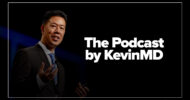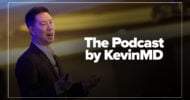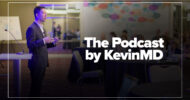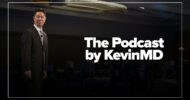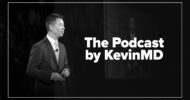Subscribe to The Podcast by KevinMD. Watch on YouTube. Catch up on old episodes!
Neurologist Ray Dorsey discusses the article “Expanding the Parkinson’s universe of care for patients, caregivers, clinicians, and communities.” In this episode, Ray reimagines Parkinson’s care through a cosmic analogy, with patients as the sun at the center and caregivers, specialists, technologies, and advocacy networks orbiting around them. He highlights challenges such as access barriers, stigma, and fragmented gatekeeper systems, and proposes a hub-based model that colocates interdisciplinary specialists, integrates research with care, and emphasizes bidirectional relationships between patients and providers. Ray also explores how technologies like telemedicine and wearables serve as satellites to extend care access. Listeners will gain insight into how this expanded model could transform Parkinson’s treatment and support for millions worldwide.
Our presenting sponsor is Microsoft Dragon Copilot.
Microsoft Dragon Copilot, your AI assistant for clinical workflow, is transforming how clinicians work. Now you can streamline and customize documentation, surface information right at the point of care, and automate tasks with just a click.
Part of Microsoft Cloud for Healthcare, Dragon Copilot offers an extensible AI workspace and a single, integrated platform to help unlock new levels of efficiency. Plus, it’s backed by a proven track record and decades of clinical expertise, and it’s built on a foundation of trust.
It’s time to ease your administrative burdens and stay focused on what matters most with Dragon Copilot, your AI assistant for clinical workflow.
VISIT SPONSOR → https://aka.ms/kevinmd
SUBSCRIBE TO THE PODCAST → https://www.kevinmd.com/podcast
RECOMMENDED BY KEVINMD → https://www.kevinmd.com/recommended
Transcript
Kevin Pho: Hi, and welcome to the show. Subscribe at KevinMD.com/podcast. Today we welcome Ray Dorsey. He’s a neurologist, and today’s KevinMD article is “Expanding the Parkinson’s universe of care for patients, caregivers, clinicians, and communities.” Ray, welcome to the show.
Ray Dorsey: Thank you very much for having me, Kevin. Delight to be with you.
Kevin Pho: So tell us a little about your story briefly and then jump right into the article that you co-wrote.
Ray Dorsey: Sure. I’m a neurologist. I care for people with Parkinson’s disease. Like most physicians, we were taught in medical school. Most diseases associated with aging are either due to aging, genetics, and maybe some combination of bad luck.
And my colleague and I wrote a book called The Parkinson’s Plan that just came out in August, in which we argue that Parkinson’s disease, one of the world’s fastest growing brain diseases, is in large part a man-made disease. Chemicals in our food, water, and air, including certain pesticides, dry cleaning chemicals, and outdoor air pollution are fueling this rise of Parkinson’s disease.
And the conclusion then is that Parkinson’s is fundamentally a preventable disease. It’s not a natural consequence of aging. It’s an unnatural consequence of aging and a preventable disease.
Kevin Pho: Tell us about some of the underappreciated risk factors of Parkinson’s disease that you certainly talk about in your book.
Ray Dorsey: Yes. One of them, the one that’s probably most well-established, is certain pesticides. Pesticides are nerve toxins. That’s how they kill insects. And one pesticide, a weed killer called Paraquat, is widely sprayed on corn, soybean, cotton fields, and vineyards throughout the United States. Research shown in 2011 showed that farmers who work with the chemical have a 150 percent increased risk of developing the disease in the laboratory.
It reproduces the features of Parkinson’s, including tremor in laboratory animals. Over fifty countries, including China, have banned it. But the United States has not. In fact, according to the U.S. Geological Survey, over the last five years for which data are available, use of Paraquat in the United States has doubled.
Kevin Pho: Let’s go on and talk about the article that you shared on KevinMD, “Expanding the Parkinson’s universe of care for patients, caregivers, clinicians, and communities.” Now, for those who didn’t get a chance to read your article, tell us what it’s about.
Ray Dorsey: In addition to the book, in addition to highlighting the preventable nature of Parkinson’s, it talks about redesigning the way care is delivered for people with Parkinson’s disease.
It starts with the premise of putting the patient at the center of the universe and then extends the analogy that what’s closest to the patient is the caregiver, and that’s the planet Mercury. Mercury can get really hot. And it can be very hard to be a caregiver. People who are caregiving for individuals with chronic diseases have their own adverse health consequences themselves.
And then it goes out to Venus, being the family and friends of the person, then the clinicians. It also talks about things that are difficult, such as the asteroid belt of negotiating insurance and prior authorizations, and then talks about Pluto, which is always there, and the stigma associated with the disease.
We put together, in addition to identifying the underlying cause of the disease, a new care model for Parkinson’s disease in the book.
Kevin Pho: Tell us about the implications of this new care model. What do you hope to achieve with that model?
Ray Dorsey: The challenge is that for people with Parkinson’s, only 9 percent of people with Parkinson’s disease in the United States see a Parkinson’s specialist, and only about 40 percent more see a neurologist. Said another way, 40 percent of Americans who have health insurance with Parkinson’s don’t even see a neurologist for their care.
And those who don’t have worse health outcomes: They’re more likely to fall, they’re more likely to fracture their hip, they’re more likely to be placed in a skilled nursing facility, and more likely to die prematurely.
We need better care models, not just for Parkinson’s, but for other chronic diseases. My real passion, though, is what can we do to prevent people from getting these chronic diseases? When you and I were in medical school, type 2 diabetes was rare. Ulcerative colitis and Crohn’s disease were rare.
Parkinson’s disease was mentioned, but you didn’t walk the streets of New York and see people with Parkinson’s disease everywhere you went. Many of these diseases are tied to factors that are in our environment and our society. If we identify what the causes of diseases are (diseases have causes), we can take action to prevent them, slow them, treat them, and eventually cure them.
We did that for peptic ulcer disease, which lo and behold was due to a bacteria. We were taught it was due to stress, and it was due to a bacteria. If we find out what the environmental causes of Parkinson’s disease are (certain pesticides, dry cleaning chemicals like this chemical trichloroethylene, and air pollution), we can take actions to prevent people from ever getting this disease and bring about its fall.
Parkinson’s wasn’t described as a major clinical entity until 1817 by Dr. James Parkinson. Writing in London, he described six people with the disease and he says, “I’m describing a disease that’s not been classified in the medical literature.” Two centuries after he describes Parkinson’s disease, the global burden of disease study estimates that 6 million people have the condition.
You go from a case series of six individuals to 6 million in the span of 200 years. It can’t be genetics. Aging alone is insufficient to explain its rise. Chemicals are fueling the rise of this chronic disease.
If we take action to prevent exposure to these chemicals, we prevent people from ever getting one of the world’s fastest growing brain diseases.
Kevin Pho: OK, let’s talk about prevention strategies. Both from a policy standpoint and an individual standpoint, what are some things that we can do to move the needle when it comes to Parkinson’s prevention?
Ray Dorsey: In the book we outlined the Parkinson’s prevention pyramid, which includes actions we can take as individuals, actions we can take in our community, and actions we can take as a society to prevent getting Parkinson’s disease. And then on page 237 of our book is the Parkinson’s 25: actions individuals can take in their everyday life to reduce the likelihood of getting Parkinson’s disease.
I’ll read the first one: “Wash your produce, even your organic ones. Pesticides have contaminated our food supply. Remnants of pesticides are found in 20 percent of common foods. Organic produce, dairy products and meat can reduce exposure, but can still have unsafe residues of pesticides. Wash your produce at least with water, and consider simple vegetable washes, vinegar, or salt solutions too.”
So we give you twenty-five very simple things. Dry cleaning, cautiously using a water filter, using an air purifier. Avoid poisoning yourself by using pesticides at home to reduce your risk of exposure to these toxins.
Then we say, what can you do in your community? We can ask our kids’ schools to stop spraying pesticides, many of which are nerve toxins, in our kids’ schools and playgrounds. Schools routinely, as I learned writing this book, spray pesticides, many of which are nerve toxins, on kids’ playgrounds in schools.
And we ask why one in 31 eight-year-olds have autism. I think we need to be a lot smarter about what we’re doing to our children and exposures in our everyday life.
And then what can we do as a society? We can ban pesticides. If China has found it in their public health interest to ban a pesticide linked to Parkinson’s, the United States can certainly do the same. We are long overdue to ban paraquat, the pesticide called paraquat.
And people can call the EPA administrator, Lee Zelin, and ask them to simply ban paraquat like England and China have done.
Kevin Pho: Now, what are some of the obstacles that prevent us from doing so? Is it the Paraquat industry? Are they fighting back, the pesticide industry?
Ray Dorsey: There’s some concern. There’s a MAHA movement in the United States and there’s some concern about regulatory capture. I think if you saw the first Maha report, it detailed the risk that pesticides present to children’s health and chronic conditions.
But its strategy was tepid. They said, “We need better spraying strategies, so less spraying occurs outside of its target.” There was a study done by Dr. Beatriz and Kimberly Paul that showed that simply living or working near where Paraquat is sprayed is associated with doubling of your risk of Parkinson’s disease.
It’s like secondhand smoke. You don’t have to be the person smoking the cigarette to be at risk of developing lung cancer, simply living near where Paraquat is sprayed. Or another study by Dr. Brittany Kowski: Simply living within a mile of a golf course is associated with a 126 percent increased risk of developing Parkinson’s disease.
Susan Sontag has this great quote: “We need to be serious, we need to be passionate, and we need to wake up.” If we’re serious, passionate, and wake up to the dangers and the likely causes of many of these chronic conditions, we can create a world where 140 million Americans don’t have a chronic condition, where 80 percent of health care expenditures are not on chronic diseases, where Parkinson’s is not the world’s leading, fastest-growing neurological disorder, where one in three 85-year-olds do not develop Alzheimer’s disease. This is all largely in our control. If we change the course, we change our behaviors, we change the course of these diseases, and we all live longer, healthier lives.
Kevin Pho: One of the things you mentioned earlier is that the minority of Parkinson’s patients with health insurance see a neurologist. What are some of the barriers preventing them from doing so?
Ray Dorsey: There just aren’t enough neurologists. There are only about forty Parkinson’s specialists trained a year. 250 Americans will be diagnosed with Parkinson’s disease today. We’re never going to get out of this by training more and more physicians.
The parable I like is the parable of the river. This small community saw these bodies coming downstream, and these bodies were damaged and injured. The community took the bodies out of the river and cared for them, and more and more bodies kept coming down the river. They got better and better at caring for them and created more and more sophisticated approaches to caring for these individuals.
They were doing such a good job that the local priests even blessed them for their efforts, but no one bothered to go upstream and to ask, “Why are these bodies coming down in the river?” We’re asking why are these bodies coming down the river. Why is Parkinson’s one of the world’s fastest growing brain diseases?
Why are one in 31 children getting autism? Why are one in three 85-year-olds getting Alzheimer’s disease? If we ask these questions, we find out the root causes of the disease and we prevent people from ever getting these diseases in the first place.
Kevin Pho: So tell us your ideal situation. If you were in charge of all policy, in your ideal world, what would you like to see happen?
Ray Dorsey: At the federal government, we can just ban paraquat. That should be done. Another chemical that is linked to it is trichloroethylene. Perchloroethylene, the most widely used dry cleaning chemical in the United States, and its cousin are associated with a 500 percent increased risk of Parkinson’s disease.
One is known to cause cancer; one likely causes cancer. The EPA has banned them with a phase-out for ten years. We can accelerate that. If people live near a contaminated site or live near a golf course or live near where Paraquat is being sprayed, they have the right to know that they’re being exposed to these chemicals.
Individuals have the right to know if they live near a Superfund site. About 20 million Americans live within a mile of a Superfund site, the most toxic sites in the U.S. People should be notified annually that they live near these sites so that they can take actions to protect themselves and their family members.
And then at the community level, we can stop spraying pesticides on kids’ playgrounds in schools. We should. Kids don’t mind weeds. We can. In California, they created the Healthy Schools Act, which banned the use of the most toxic pesticides on kids’ schools and required schools to notify parents in writing in advance of the use of pesticides.
That same thing can be applied across the country. There are a wide range of things that we can do to take actions to prevent people from not just getting Parkinson’s disease, but likely other neurological disorders as well.
Kevin Pho: Are there any major initiatives in our country for any one of the things that you just mentioned?
Ray Dorsey: The trichloroethylene and perchloroethylene were banned in late 2024. The current administration put a freeze on that ban. My understanding is that freeze is going to end and that this ban will be put into place, so it can be done.
Europe has banned Paraquat. Europe got rid of trichloroethylene. Europe’s air quality has improved, and it appears that the number of new cases of Parkinson’s in Europe adjusted for age might be peaking, if not beginning already to fall. We can do the same thing. In our book, we outlined that our goal by 2035, ten years from now, if you have me back as a guest, is that the rise of Parkinson’s disease is 0 percent adjusted for age in the United States. We have a 0 percent rise.
And the incidence of Parkinson’s adjusted for age. In 2036, we start talking about the fall of Parkinson’s disease. Diseases come and go. Infectious diseases did not really occur in humans until about 10,000 years ago when we had the agrarian revolution and populations and cities were formed, which allowed the spread of infectious diseases.
And we’ve said goodbye to smallpox. We’ve largely said goodbye to polio. We’ve largely said goodbye to yellow fever. We’ve said goodbye to a wide range of infectious diseases. We’ve said goodbye to bleeding ulcers. When we were in training or before we were in training, peptic bleeding ulcers was a top-ten leading cause of death in the United States.
You and I saw lots of people coming in with bleeding ulcers in our training. Now it’s almost a non-event because we found out what the cause of the disease is, and we’re saying goodbye to bleeding ulcers. We can say goodbye to Parkinson’s disease, to a large portion of it. We can say goodbye to a large portion of ALS.
These diseases have very little to do with genetics, a lot to do with the environment. If we change our environment and get rid of pesticides, certain pesticides on our kids’, schools, playgrounds, sports fields, water, and our air.
Kevin Pho: How about in the primary care setting? What are some of the questions that I can ask in my exam room to make patients more aware of the preventable causes of Parkinson’s, and what can I do to better coordinate care for those with Parkinson’s?
Ray Dorsey: I think the first thing that we have to do as clinicians, when we find someone with a diagnosis, is to ask why. In our book we outlined a plan: P is to prevent the disease, L is to learn why, A is to amplify the voices of those affected, and N is to navigate the frontier treatments.
But once you learn why someone has a disease, you can take action, better action, to address it and to prevent it. If someone comes in with lung cancer, you’re going to figure out why they have lung cancer. Is it because they have radon in their house? If they have radon in their house, they need a radon remediation system to prevent them from getting ongoing exposure to radon.
If they’re smoking, you’re going to counsel them to stop smoking. But if a farmer comes in with Parkinson’s disease, are we telling them to limit their exposure to pesticides? If someone works with a degreasing chemical and comes in with Parkinson’s disease or cancer, like non-Hodgkin’s lymphoma linked to trichloroethylene, are we asking them if they work with these chemicals and telling them to stop getting exposed?
And in the book, we give you twenty-five recommendations that individuals can take to prevent or reduce their exposure to these chemicals, to either slow the rate of progression of the disease possibly, or to prevent them from getting it. We should figure out why people get diseases so we can prevent them, slow them, treat them, and eventually cure them.
Kevin Pho: We’re talking to Ray Dorsey. He’s a neurologist who co-wrote the KevinMD article, “Expanding the Parkinson’s universe of care for patients, caregivers, clinicians, and communities.” Ray, what are some take-home messages that you want to leave with the KevinMD audience?
Ray Dorsey: One of the world’s fastest growing diseases is Parkinson’s disease. It is not an inevitable consequence of aging. Chemicals in our foods (like certain pesticides), in our water (like dry cleaning chemicals), and in our air (like outdoor air pollution) are fueling the rise of the disease.
If we take actions as individuals to limit our exposure to these chemicals (water filters, air purifiers, testing your water for pesticides), in our communities (asking our schools to stop spraying toxic pesticides on our kids’ playgrounds and sports fields), and as a society (banning the pesticide called paraquat), we can create a world where Parkinson’s disease is increasingly rare instead of increasingly common, and we can be part of the generation that brings about the end of Parkinson’s disease.
Kevin Pho: Ray, thank you so much for sharing your perspective and insight. Thanks again for coming on the show.
Ray Dorsey: My pleasure.








